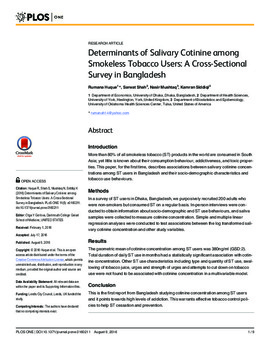| dc.contributor.author | Rumana Huque | |
| dc.contributor.author | Sarwat Shah | |
| dc.contributor.author | Nasir Mushtaq | |
| dc.contributor.author | Kamran Siddiqi | |
| dc.date.accessioned | 2017-03-05T23:40:56Z | |
| dc.date.available | 2017-03-05T23:40:56Z | |
| dc.date.issued | 2016-08-09 | |
| dc.identifier.citation | Huque R, Shah S, Mushtaq N, Siddiqi K (2016) Determinants of Salivary Cotinine among Smokeless Tobacco Users: A Cross-Sectional Survey in Bangladesh. PLoS ONE 11(8): e0160211. doi:10.1371/journal.pone.0160211 | en_US |
| dc.identifier.uri | https://hdl.handle.net/11244/49293 | |
| dc.description | | en_US |
| dc.description | | en_US |
| dc.description.abstract | Introduction More than 80% of all smokeless tobacco (ST) products in the world are consumed in South Asia; yet little is known about their consumption behaviour, addictiveness, and toxic properties. This paper, for the first time, describes associations between salivary cotinine concentrations among ST users in Bangladesh and their socio-demographic characteristics and tobacco use behaviours. Methods In a survey of ST users in Dhaka, Bangladesh, we purposively recruited 200 adults who were non-smokers but consumed ST on a regular basis. In-person interviews were conducted to obtain information about socio-demographic and ST use behaviours, and saliva samples were collected to measure cotinine concentration. Simple and multiple linear regression analyses were conducted to test associations between the log transformed salivary cotinine concentration and other study variables. Results The geometric mean of cotinine concentration among ST users was 380ng/ml (GSD:2). Total duration of daily ST use in months had a statistically significant association with cotinine concentration. Other ST use characteristics including type and quantity of ST use, swallowing of tobacco juice, urges and strength of urges and attempts to cut down on tobacco use were not found to be associated with cotinine concentration in a multivariable model. Conclusion This is the first report from Bangladesh studying cotinine concentration among ST users and it points towards high levels of addiction. This warrants effective tobacco control policies to help ST cessation and prevention. | en_US |
| dc.language.iso | en_US | en_US |
| dc.publisher | PLos One | |
| dc.relation.ispartofseries | PLoS ONE 11(8): e0160211 | |
| dc.relation.uri | http://www.plosone.org/article/info%3Adoi%2F10.1371%2Fjournal.pone.0160211 | |
| dc.rights | Attribution 3.0 United States | |
| dc.rights.uri | https://creativecommons.org/licenses/by/3.0/us/ | |
| dc.subject | Tobacco,Saliva,Nicotine addiction,Swallowing,Linear regression analysis,Smoking habits,Behavioral addiction,Questionnaires | en_US |
| dc.title | Determinants of Salivary Cotinine among Smokeless Tobacco Users: A Cross-Sectional Survey in Bangladesh | en_US |
| dc.type | Research Article | en_US |
| dc.description.peerreview | Yes | en_US |
| dc.description.peerreviewnotes | http://www.plosone.org/static/editorial#peer | en_US |
| dc.identifier.doi | 10.1371/journal.pone.0160211 | en_US |
| dc.rights.requestable | false | en_US |

